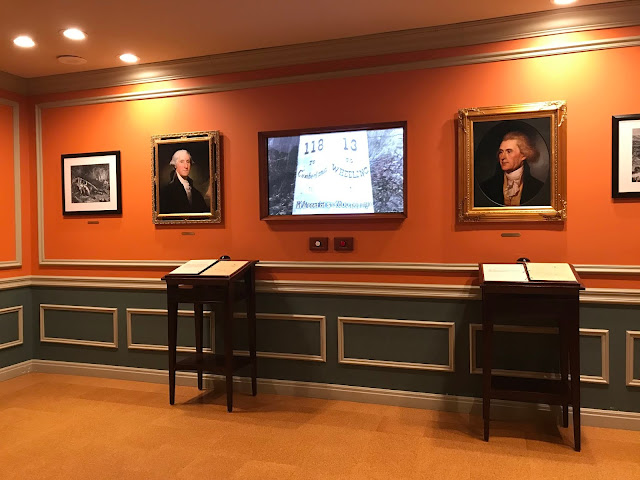The visitor center was very well done and had a LOT of fun things for kids to do.
There was a desk area, store and a nice showing of artifacts not in the museum. As you can see by the flags hanging, this location dealt with the French, English and Americans.
Plus there was a nice exhibit there.
The battle at Fort Necessity was the beginning of the French and Indian war during the summer of 1754. The French and Indian War was a dispute of British, French and American Indian cultures and eventually ended with the removal of French power from North America. The land in dispute was the Ohio River between the Appalachian Mountains and the Mississippi in 1750. By 1753, Governor Robert Dinwiddie of Virginia learned the French had built forts in areas claimed by Virginia and the governor sent George Washington with eight men to warn the French to withdraw. At this time, George Washington was only 21 years old. The French refused to leave and George reported this back to the governor. So, in January 1854, Governor Dinwiddie send a small force to build a fort at the forks of the Ohio River where Pittsburgh is now. The stockade was barely finished when the French drove off the men and built a larger on it it's place they called Fort Duquesne. By April, George Washington, a newly appointed lieutenant colonel took some men to build a road which is now Brownsville, PA and was told to help defend the fort on the Ohio and this began the Fort Necessity Campaign. When he got to the fort, he learned it was now in French hands and waited further instructions while still building the road. Then, Col. Joshua Fry arrived with the rest of the Virginia Regiment.
Long story short, George Washington, camped at the Great Meadows, took a few men by dark of night to spy on the French but out of nowhere someone fired a shot (no one knows by which side), causing a skirmish where 13 French men died including Joseph Coulon de Jumonville and 21 captured and 1 men on George's side died with a couple injured. The French blamed us and we blamed the French. Washington feared a backlash from the French and he build a round fort, he called Fort Necessity. He found out Col. Fry had died and now was promoted to colonel and had 9 small cannon and 293 men.
But, there's more. The British sent Major General Edward Braddock from England with 45 years of military service and he would be commander-in-chief in North America with George Washington as his aide. The plan of 1755 was to simultaneously attack as many French forts as possible. Braddock would lead against Fort Duquesne heading down the road that Washington built previously but they had to widen it for all the wagons and artillery. When they got to the fork in the road, the army split with Braddock heading toward Fort Necessity and Col. Dunbar toward the Ohio Forks. The Battle of Monoghahela ensued and the British fell apart in total chaos. Braddock was severely injured with terrible British losses. The British camped just a mile from old Fort Necessity and Braddock died and is buried on the road about 1/4 miles from Fort Necessity and the Tavern and the army marched over the grave so there were no traces of it toward Pennsylvania. And, the war continued. Fort Necessity saw it's share of hardships for the British.
Also at this location was George Washington's Tavern that was built on the road that he made called the National Highway. This was a stopping point along the road for travelers. There was a main hallway with a parlor, dining room and a bar room on the main floor and also had two additional floors of bedrooms that were for overnight visitors. It's beautifully decorated!














































No comments:
Post a Comment